Only if we stick our brains together, learning from and with each other, across our existing silos, we will be able to solve todays complex tasks… via sharing.
#SHARING is a fairly new term for many, which has a variety of meanings. Some see it as sending a file via eMail or „uploading a final document“ to a SHAREpoint, others experience it as a collaborative, social learning journey. With this post I want to „share“ my experience and mission and perspectives around sharing.
If the organization does not value sharing (where many win)
over focus & competition (where one wins),
it will suffer over time.
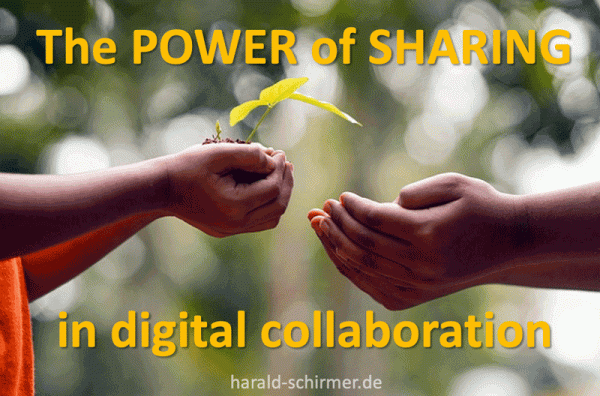
Reflection on meanings of „sharing“
We understand very different things, when speaking about sharing – which is also connected to conflicting emotional perspectives (for some it is a threat, for others appreciation)
Some examples what we call „sharing“:
- putting a final file somewhere in a file share (e.g., SharePoint)
- sending out a newsletter or email
- posting something in a closed chat channel
- giving access to a group of people to a folder
- creating a lessons learned document and upload it into a database
- communicating something in a call or video conference (one to many)
- sharing internally in an Enterprise Social Network in a blog, forum or wiki: insides / progress / knowledge / results / likes / comments
- sharing final results versus sharing progress
- sharing responsibility in preparing or even taking responsibility
- sharing their job with someone
This post is an attempt to create a bit more clarity on the term of sharing (with focus on collaboration in work teams or organizations and the impact of digital transformation)
Physical versus Digital Sharing
First we have to distinguish between physical and digital meaning of sharing:
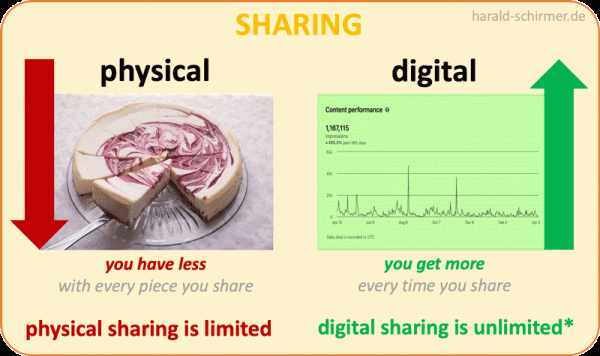
If you share something in the physical world, you have less of it ( as physical objects need to get divided ), while in the digital world, you keep it with full control AND others get it too (by granting access or multiplying it)
Sharing by PUSH vs PULL
Next, focusing on digital sharing, it makes all the difference, if we PUSH something to (typically determined) receivers or if we make things available for others, to be PULLed, when and where they need it.
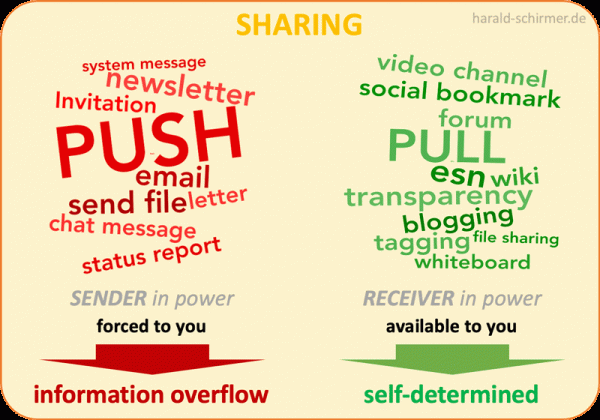
As the amount of people and tools pushing information to us is constantly growing, as well as the speed, when that happens – the logical result is information overflow – and the feeling of being controlled (steered) by others.
Same with the effort, as you have to deal with every message pushed into your mailbox: read, delete, sort, archive, reply…
If the information is shared at a central place (cloud, ESN, social channel), you can have it, when you need it – anytime, anywhere. This fundamental availability combined with a valuable network and powerful filters (e.g., #Hashtags) ensures, information relevant to you will find you in time!
Details on PUSH / Sending:
There are good reasons for sending things, sometimes it is technically the only available option, but „sending“ has many disadvantages. Unfortunately it still is the default for many (as we have a history of being hunters and collectors – we want to „own“ things)
- you multiply information, documents, cause many copies, it takes up storage and bandwidth, increases individual effort for structuring and central effort for archiving
- you loose overview – who has copies, what is the latest version, people using outdated versions
- you loose control over it – (sending means handing it over – technically little options to call it back, update it or lock it), some might further distribute without your knowledge or permission
- you create unneeded copies for yourself (personal storage, email outbox and inbox and team-channel)
- you can not edit it anymore, once sent (in case you forgot something or need to update only a small part – you have to re-send everything to everyone)
- sending for review or rework is a nightmare with more than one recipient, resulting in lots of extra effort in consolidation and aligning with all involved > click here to see a calculation
- even only sending a link via eMail is helping only one once, sharing a link as status update of social bookmark with at mention, can help many from now on (with same effort on your side)
Details on PULL / Granting access
Since we have the internet and cloud solutions, sharing became a better option for many information, knowledge and collaboration topics. The advantages of sharing by granting access (documents, information in a blog, wiki, forum, intranet) works perfect for things needed more than once, by more people (which fits basically to anything, which does not need specific protection)
- you stay in control over content and responses
- you can update, delete at any time
- you reduce CO2 by reducing storage need, bandwith, archiving need – only those, who want it, download it
- you reduce effort for alignment, as the transparency (content, like, comments) are always visible to all
- you give structure and reliability – there is only ONE version in ONE place with clear indication on who, when, what was changed
- you can dynamically react on feedback (e.g. in comments) and make updates, corrections, additions (with no need of extra communication)
- it reduces your effort for communication dramatically – questions can easily be answered without any effort directly (pull) or by just sharing a link to the content
- it builds your digital reputation as a „value creater“
- it helps growing a sharing culture with your role modeling
- it enables „serendipity“ add value by connecting your knowledge with someone, you would have never thought of – when he/she needs it (by network scaling, relevance and resonance)
An additional aspect is changing from sharing documents to using co-creative , web-based formats, where the limitation by tool-providers and the fluidity of collaborative editing is in focus. Older formats like blog, forum, wiki or more modern tools like whiteboards and pinboards.
Content vs People centric
We are very used to create, review, share and organize content – knowledge, information, files, data. Content focused sharing requires fixed structures and typically managing roles to make sure things can be found according to the designed structure. Experience shows that most of such storage solutions fail, once people (diversity of humans kills one-size-fits-all solutions) start working with it (resulting in empty folders, outdated & inflexible structures, internationality/language issues, double entries, not being user friendly, hard to find the needed things…)
Even if they are perfectly maintained, you need to force people with processes to use it, in a given way, for value creation.
Handling information in a people centric way respects that we are all different and have different needs. By adding „relationships“ (via networks) and „individual relevance“ (via filters and instant feedback) as well as „process transparency“ (who, what, when, where), people are able to handle infinitely large amounts of information, sources and people – on demand. (once educated)

We need structured content sources – no doubt, but real value for humans develops, once the content/information is available, when needed and best by a trusted source (person) you can contact, if needed.
In a complex environment (digital transformation / VUCA), knowledge and information is less stable and reliable. „It depends“ what perspective is relevant, what data helpful and which content helpful.
Complexity can not be solved by simplicity – so it will not be one document or sentence or one solution succeeding, but a variety of them – even changing over time. This dynamic needs ideally ALL OPTIONS being available for everyone – easy to be pulled or connected with by others.
What started with hyperlinks
connecting content in the early internet,
now makes connected
people in networks powerful
(via social networks),
which enables swarm intelligence.
Knowledge becomes valuable, once people use, discuss, update, challenge, extend it – I call that „living knowledge“ with the intent to be applied and experiences about that shared again.
Content
(a book, a database, a perfectly structured content storage)
does not solve any problems
or create productivity,
people do.
Content storage can be used as sources, but on top of it, the value is in HOW, WHEN, WHERE and BY WHOM it is applied – adding transparency about that is sharing and will enable the organization to become a learning organization.
It will be interesting to see the impact of artificial intelligence on the needs of structured content and handling knowledge or its authentication.
Pre-Requirements for digital, people centric sharing
In order to be able to allow people centric sharing and building a sharing culture, there are 4 important aspects to fulfill:
(based on the original model from Benedikt Scheerer/Cogneon with 3 perspectives)

You need the right TOOLSET for sharing:
To digitally, scalable share, you need an enterprise social network platform (ESN). This platform has to be „people centric“ (not content centric like file storage, CMS Intranet or ChatClients). The five technical minimum requirements are:
- A personal profile for self introduction
- Ability to follow and connect to networks
- Social content (text, audio, video, links…)
- Feedback options (likes and comments – being shared to whole network)
- Filters like #Hashtags to connect, combine, select relevant topics
I would also add a valuable algorithm, that enables creation of a movement by displaying more relevant content (with more views, likes, comments) more prominent. (which is currently missing in Mastodon)
Check out this post to learn more about needed tools
Required sharing SKILLSET:
Having an ESN solution is great, even more important is to use it and differentiate which tool/feature supports which goal. Learning how to develop from push communication in a default closed environment to a pull (making things available) default open attitude is a needed digital competence (which also is way more efficient and effective for collaboration). This includes knowing how to apply filters, getting relevant search results, handling options and being able to understand/evaluate information sources.
Sharing behavior driven by your attitude / MINDSET:
Having a “need to know” mindset not only in an organization harms knowledge sharing.
We have been told that:
- we can not collaborate with large groups, (many cooks spoil the broth)
- trust works only in person (you can’t fax a handshake)
- hierarchy is a fundament of structure / reliability / stability
- competition is needed
- we need heroes… winning alone is easier (if you want to have it done, better do it yourself)
- and „the crowd is stupid and lazy“
With such a mindset (set of beliefs)
we can not win
in a globally connected, complex,
dynamic, volatile and ambiguous world.
As hard as a mindset shift is – and it is needed, as it steers our behavior, all organizations have seen the need already and – mostly informal – drive it with various mindset changing initiatives: values, ownership, diversity, new work, flexibility, agile, customer centric, design thinking, transformational – emotional leadership, feel-good management, culture development… all those measures try to make us ready for the VUCA world.
The efficiency & impact of SHARING
or in other words, people refusing SHARING are likely to mistrust their people
is directly related to our trust level
If we trust our people, if we role model good behavior, if we share not only what we do, but how – we can reduce rules, roles, processes and effort dramatically.
Sharing is an esential part to experiment, learn, feedback, promote and appreciate this new mindset.
Changing rules, roles, processes with a new FRAMESET:
What makes the sharing process sustainable/formal: how to embed sharing into our organizational operating system – how to change roles, rules, processes and with that commitment and consequences.
If you compare e.g. the topic of compliance which is a formal organization with roles, rules and processes – sharing is approached informally with a „can do“ mentality. (a first step could be making sharing a pre-requisite for career, or an evaluation topic in employee dialogs, a part of a project requirement – like lessons learned) Organizations typically protect their knowledge but the harm of not being able to use its own knowledge is a problem since decades.
(If the company knew, what the company knows)
I am not in favor of making sharing mandatory or connecting hard rules to it.
Digital sharing should grow
on the fundament of
values base social interaction
I would prefer more to have only very few kpi’s in our career plans like a minimum size of a network (without a network, sharing makes no sense) and maybe an visible indication of minimum „reach/interactivity“ of a profile, which than can be used for appreciation or education initiation.
(3-4 levels would be maybe enough like in forums: starter, practitioner, role model, influencer)
The productivity trap with sharing:
Productivity is seen as core of an organization and for most managers reporting is key… „facts are friendly“ (including „what gets measured, gets done“)…
„Sharing“ does not have
the reputation of being productive,
yet…
Maybe our idea of „being productive“ (coming from the physical labor history, where results per time was a key measure) should change at least in a knowledge worker environment.
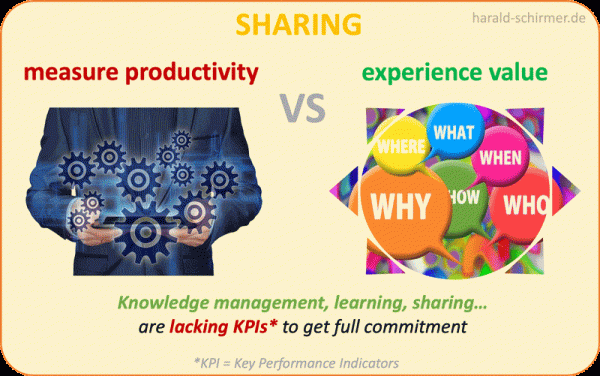
Typical aspects to increase productivity are lean management and setting efficient processes to get work done with least amount of „time without value“. The result: today we are all in a „constant acting“ mode. The time, with thinking, waiting, learning, informal exchange, social interaction, doing nothing have been cut off (with all the negative results like fluctuation, burn out, missing connections…) The spiral to waste-less productivity can only result in us as humans being taken out of the process. Once only robots and software (AI..) outperforms in speed, endurance, quality – while never being sick on strike or having „purpose“ issues.
In reference to our resource situation on our planet, productivity in a circular economy focusing on CO2 reduction and long lasting products with minimum (or better no) waste, we have to re-define productivity with „sustainability“ in mind.
Once we have reached 100% productivity
(by taking humans out of our processes), what is our value contribution?
Than latest, we need to focus on our human competences again: creativity, social interaction, sense making, holistic and sustainable perspectives, innovation, solidarity… all that requires US to CO-CREATE – learn, share, discuss, experiment, design, adjust… adding more attention to this (and delegating productivity to machines) seems to me a much better time invest into a more human future.
For sharing to get more relevant attention now, we need might need to be able to „calculate“ the benefits of sharing or – maybe easier – the loss an organization suffers from lacking a sharing culture – to win over todays management.
Without sharing, an organization this could occur:
- being too slow or not responsive enough, as answers can not be found fast enough
- double work, as the wheel gets re-invented over and over again
- inefficiency, as great methods, formats, solutions stay in silos
- lacking collaboration, as knowledge and experience stays within teams, projects or departments
- loosing knowhow, as people leave for many reasons (new job, retirement) taking all their knowhow and experience with them
- reduced innovation as serendipity (or swarm intelligence) can not be used for inspiration, rapid solutions
- more risks, as network based early warning can not be establised
- missing customer centricity, if this is just a „topic of a role“, not a shared mission (employees are also customers – besides that, it is unlikely that employees not networking internally, are able to do it externally)
- reduced sense of belonging by everyone working by themselves or in small teams only – a shared great people culture can not be experienced
- fear culture by intransparency… as the opposite of a sharing/feedback culture is hiding information avoiding questions or feedback and „extra effort“ with it
We are in a
“getting things done”
productivity trap
Sharing knowledge, exchanging in networks, learning would “sharpen our saw” but, at first, reduce our own getting things done level. Knowledge Management tried for decades to proof it’s value, but failed to deliver clear measures, even so not many would argue, that it is not valuable.
We can ask ourselves:
is learning, sharing, helping others
seen as productive?
The „usability“ issue
In my consultancy/workshops and keynotes with many organizations, I hear: the Enterprise Social Network Platforms are not user-friendly, or self-explaining!
Yes, they are right, ESNs really need to upgrade, if we compare them to their peers in the internet. On the other hand, we are very much condtitioned by the big companies and their user interfaces, which is why integrated chat tools nowadays are much more in favor, as a separate, web-based platform.
People use CRM, LMS even ugly travel management tools (because they have too) – in the end, it is the missing commitment (and often fear of loosing power e.g. by new work styles, transparency, working on eye level…), which keeps them from using it.
The argument of „not being self-explaining“ – in my eyes – is mainly related to the fact, that ESN is not just another tool, but requires a different communication behavior.
If you copy your eMail behavior
to chat or ESN, you have to fail.
What I also see very critical, is that there is a stagnation or even backwards development for ESN (there are only very few real ESN providers out there). The majority also only allows social „communication“, not social „collaboration“.
Click here to learn about the fundamental aspects of a real ESN social network
If leaders adopt to ESN,
people will follow!
As usually in hierarchical organizations, Leaders can make all the difference!
In all my projects, where I decided to make ESN the center of it – working in a more transparent and participative (inclusive) work style, colleagues adopted very fast by seeing/feeling the benefits in interaction, contribution and creating impact with that, while adding to their personal reputation… and… reducing effort too.
Last but not least, I am convinced that even the best usability would not make everyone automatically a social sharing expert, but even with a lousy ESN tool and committed role models, you can experience outstanding network-power and sharing effects.
Personal hurdles & benefits of sharing?
We don’t learn much from final results – the progress is, what gives us insights and what creates a culture we like to be part of.
Good sharing is
(WHAT is a dead product, HOW is a living process)
less WHAT we do,
but HOW we do it…
Humans are emotional, not number crunching robots perfectly following an algorithm – emotions are the anchors for knowledge to stick. Sharing how we do things (story telling) or what we feel, think… helps others to connect. Sharing is an investment for both, the ones who share and for the ones who read it. Sharing also (initially) takes courage* -> people need to see a benefit and must gain something from sharing.
*sharing takes courage as most people are hesitant against publications to an unknown and eventually very large audience – without expiration date.
We typically also think, we should only share “great, reliable, high quality stuff” (which is a big hurdle and is a lot of effort). But for most people, a small topic is much easier to digest, it is valuable already and offers a faster option to decide, if they want to invest time in reading/viewing it. Don’t aim so high! Our expectation on what is valuable to be shared is much higher than for the others.
A good start is to share a small progress of something, which is important to me.
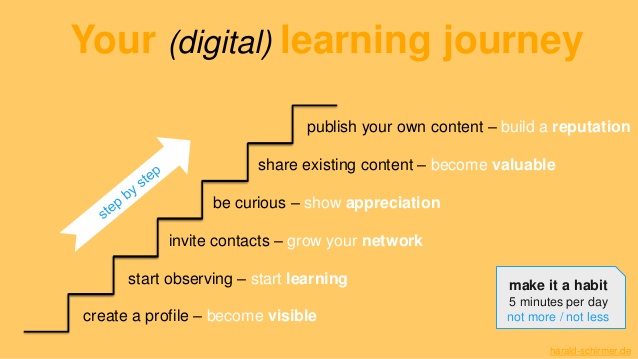
Information flow in a social platform is very high and fast and seems un-structured – once we learn how to filter, connect, deal with options, we will be able to HANDLE COMPLEXITY… an urgently needed skill for the digital world
So what is in it for me?
- Recognition, instantly and long term, for what you share
- Self esteem, by getting appreciation
- Self efficacy, by seeing your impact
- Responsiveness – fast answers to urgent questions
- Peace of mind, knowing help is always a click away
- Inspiration from your network
- Access to relevant stakeholders
- Friendships, even asynchronous and over long distance
- Sense of belonging, with those, you interact
- Competence constantly growing by this learning channel
the list gets longer, once you get started investing in your future.
What is the gain from sharing for the organization?
The new tools, formats and methods in the digital age like ESN came up to overcome the limitations of former options. Their goal is to be able to deal with:
- more people (without limit)
- more dynamic (faster, more efficient, scalable)
- more input (big data, huge and many sources)
- more complexity (without dis-respectful simplification)
- more perspectives (celebrating diversity and options)
- more internationality (automated translation)
- less effort (production, distribution, filtering, updates, storage, archives…)
The organization also benefits from everything, their people benefit from, plus advancing an:
attractive, inclusive and
sustainable solution culture.
The networks will reduce risks, drive innovation and responsiveness to customer or marked demands.
Sharing is a great fuel for your organizations growth (learning, experiementing, leading, connecting, cocreating)
Two typical management issue with sharing…
NO TIME
A big topic, of course ist making time (priority) for learning how to share and making it a habit. Unfortunately it is a circle that has to be broken: no time for learning/sharing results in less efficient and even less time … actually it is a spiral directly leading into burnout (individually or as organization).
The way out: STOP > invest some time in learning regularly > enhance your methods, formats, tool knowhow, knowledge, competence > gain MORE TIME for learning (with sharing) AND being more productive at scale. (less effort, more impact)
- click here to learn more about the „no time“ dilemma

INFORMATION OVERLOAD
It is hard to explain, that the solution for suffering from information overload already in eMail and Chat, will be in adding another channel.
Even more crazy, if that channel looks like the worst case, all open, everyone in „Social Platform“ (with a external partly negative reputation of offering meaningless food images, time wasting cat videos or enabling shitstorms).
- click here to learn more about reducing Information Overload
But yes, sharing in a social platform is a great solution to reduce communication effort, increase solution speed and impact while learning and getting more appreciation than ever before.
I have to admit, that can not be expained in an elevator pitch – here is a post about „many of the reasons and arguments“ (from many international experts)
Resume
ChatGPT just lately showed us, that knowledge is everywhere and access to it just became dramatically easier. The need of self-development in sense making, asking good questions (prompts), understanding sources, imagination and critical thinking… is our best way to learn from and with each other … via sharing.
Only if we stick our brains together – across our existing silos, we will be able to solve todays complex tasks. I am very confident, that together we can find and realized valuable solutions, on which we can be proud of. The fundament is that we talk to each other… Social Media is a „channel“ which can serve this need, if we understand and use it in a mature way.
#WEwins
with the power of social networks

Schreibe einen Kommentar